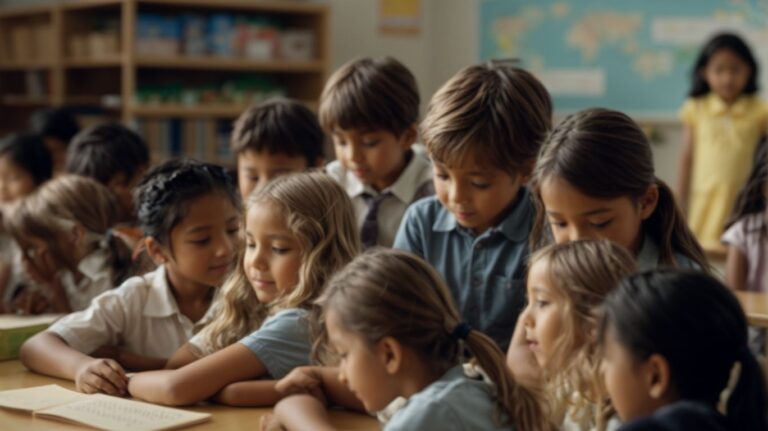Perceptual development is a crucial aspect of human growth that shapes our understanding of the world around us. In this article, we will explore the different types of perceptual development, how it occurs, and the factors that influence it.
From the stages of perceptual development to the key theories in psychology, we will delve into the key milestones and their impact on cognitive, social, and emotional development. Join us as we unravel the fascinating world of perceptual development and its significance in human growth.
Contents
- 1 What Is Perceptual Development?
- 2 How Does Perceptual Development Occur?
- 3 What Are The Theories Of Perceptual Development?
- 4 What Are The Key Milestones Of Perceptual Development?
- 5 How Does Perceptual Development Impact Other Areas Of Development?
- 6 Frequently Asked Questions
- 6.1 What is perceptual development and why is it important?
- 6.2 How does psychology contribute to our understanding of perceptual development?
- 6.3 What are some examples of perceptual development in infants and children?
- 6.4 Can perceptual development be influenced by environmental factors?
- 6.5 How does perceptual development change over the lifespan?
- 6.6 What are the potential implications of understanding perceptual development?
What Is Perceptual Development?
Perceptual development in infants and toddlers refers to the gradual process through which they learn to interpret and understand information received through their senses, shaping their interaction with the surrounding environment.
This important stage encompasses how young children explore their sensory abilities, like touch, taste, sight, smell, and hearing, to make sense of the world around them.
Infants often discover textures by feeling various objects, tasting different foods, observing vibrant colors, hearing music or voices, and smelling distinct scents.
Through these sensory experiences, they start forming cognitive connections and associations, helping them learn about cause and effect, spatial relationships, and object permanence.
What Are The Different Types Of Perceptual Development?
Perceptual development encompasses various sensory domains, including vision, hearing, smell, taste, and touch, each playing a vital role in shaping a child’s understanding of the world and fostering sensory play experiences.
Visual perception allows children to interpret their surroundings through sight, recognizing colors, shapes, and movements.
Auditory perception, on the other hand, enables them to pick up sounds and understand language, enhancing communication skills.
Tactile sensation via touch helps children explore textures, temperatures, and object properties, enhancing their fine motor skills.
Olfactory and gustatory senses, related to smell and taste, respectively, contribute to a child’s experiences with food, safety, and memory formation.
By engaging in sensory play activities that stimulate these domains, children can develop a well-rounded perception of the world around them.
How Does Perceptual Development Occur?
Perceptual development in infants and toddlers occurs gradually through interactions with caregivers, exposure to stimulating environments, and engagement with sensory-rich stimuli such as mirrors, toys, and sensory play materials.
During the early years of life, children rely heavily on their senses to explore the world around them. Caregivers play a crucial role in this process by providing a nurturing and responsive environment that supports sensory awareness and cognitive development. By creating opportunities for sensory play, caregivers can facilitate the development of key sensory skills like touch, taste, smell, sight, and hearing. These experiences help children in making sense of their surroundings, forming connections between different stimuli, and laying the foundation for future learning.
What Factors Influence Perceptual Development?
Perceptual development in infants and toddlers is influenced by various factors, including the richness of their environment, the availability of sensory play opportunities, and the quality of caregiver interactions.
The text is already well-formatted with HTML tags such as for bold formatting within a
tag. The content is clear and structured.
What Are The Stages Of Perceptual Development?
Perceptual development in infants and toddlers progresses through distinct stages, marked by advancements in sensory processing, motor coordination, and physical development, shaping their perceptual abilities and cognitive skills.
During the initial months, infants rely heavily on their senses of touch and taste, exploring the world through mouthing objects and feeling different textures. As they grow, their visual abilities improve, allowing them to track moving objects and recognize familiar faces. Motor skills also develop rapidly, evident in their ability to grasp objects, roll over, and eventually sit up independently. With time, toddlers refine their hand-eye coordination, enabling them to stack blocks, scribble with crayons, and engage in more complex play activities that require dexterity.
What Are The Theories Of Perceptual Development?
Several theories explain the process of perceptual development in children, including Piaget’s cognitive developmental theory, Dr. Berry Brazelton’s neonatal behavioral assessment, and Jean Barbre, EdD’s approach to sensory play.
These influential theories shed light on how children interact with their environment, interpret sensory stimuli, and acquire new knowledge.
Children’s perceptual abilities evolve gradually, starting from birth and continuing through the early years.
Piaget emphasized the role of experience in shaping a child’s understanding of the world, while Dr. Berry Brazelton focused on the behavioral patterns exhibited by infants to understand their cognitive processing.
Barbre’s emphasis on sensory play highlights the significance of engaging all senses for holistic cognitive growth.
Constructivist Theory
The constructivist theory of perceptual development posits that infants and toddlers actively construct their understanding of the world through sensory exploration, cognitive assimilation, and schema formation.
From birth, infants begin making sense of their surroundings by touching, seeing, hearing, tasting, and smelling. They observe patterns, form mental maps of their experiences, and adapt their existing knowledge structures to accommodate new information. Schema development plays a crucial role, whereby infants organize their perceptions and actions into mental representations.
Through interactions with caregivers and the environment, infants refine their cognitive schemas, gradually building a scaffold of knowledge that shapes their future learning processes. This continuous cycle of active engagement, reflection, and adaptation defines the constructivist approach to perceptual development in early childhood.
Ecological Theory
The ecological theory of perceptual development emphasizes the role of the environment in shaping infants’ sensory experiences, highlighting the importance of adaptive behaviors and environmental influences.
Infants, through their interactions with the surrounding environment, learn to make sense of the world and develop the ability to perceive and respond to various stimuli. The ecological theory posits that infants’ cognitive development is intricately linked to their sensory experiences, as they navigate and explore their surroundings.
These early sensory perceptions play a crucial role in shaping how infants interact with their environment, fostering adaptive responses that aid in their overall growth and understanding of the world.
Dynamic Systems Theory
The dynamic systems theory of perceptual development views infants and toddlers as complex systems that continuously interact with their environment, adapt to sensory inputs, and develop perceptual skills through active exploration.
Infants, through their innate curiosity and drive to explore the world around them, engage in a multitude of sensory experiences that shape their cognitive processes. These interactions involve sensory-motor integration where they learn to coordinate their actions with sensory information, leading to the foundation of perceptual understanding.
By manipulating objects, touching different textures, and observing the reactions of their environment, infants refine their perceptual abilities, gradually forming a coherent picture of the world. This approach emphasizes the importance of the interplay between sensory stimuli, physical movements, and cognitive development in shaping a child’s perception and understanding of the environment.
Information Processing Theory
The information processing theory of perceptual development focuses on how infants and toddlers encode, store, retrieve, and manipulate sensory information, emphasizing cognitive processing and attention mechanisms.
Infants, through this theory, are seen as active processors of information, taking in sensory inputs from the environment, such as sights, sounds, and textures.
As they assimilate and accommodate these inputs, their attentional capacities develop, allowing them to gradually filter out irrelevant stimuli and focus on pertinent information.
This ability to allocate attention efficiently is crucial for engaging in cognitive activities related to perceptual tasks, enabling them to decipher patterns, recognize familiar objects, and make sense of the world around them.
What Are The Key Milestones Of Perceptual Development?
Key milestones in perceptual development for infants and toddlers include advancements in visual perception, auditory discrimination, tactile sensitivity, olfactory recognition, and gustatory exploration, all contributing to their overall physical and cognitive growth.
Visual perception in infants begins to develop shortly after birth, with newborns being drawn to contrasting colors and patterns. As they grow, infants start tracking moving objects with their eyes, a sign of improving depth perception. Similarly, auditory discrimination is honed as babies can differentiate between various sounds and tones, forming the basis for language acquisition.
Tactile sensitivity plays a crucial role in early motor skill development, as infants explore textures and surfaces through touch. This exploration aids in refining fine motor movements and hand-eye coordination, essential for future tasks like writing and drawing.
The olfactory recognition in infants is remarkable, as they can differentiate between familiar scents and strangers, establishing early preferences and memories linked to smell. Gustatory exploration, or exploring tastes, helps in shaping food preferences and creating a positive relationship with eating, laying the foundation for healthy eating habits later in life.
Visual Perception
Visual perception development in infants and toddlers involves the ability to track moving objects, focus on near and distant stimuli, recognize familiar faces, and perceive depth and colors in their visual environment.
As infants and toddlers advance in their visual development, they begin to demonstrate a heightened awareness of shapes, sizes, and textures.
Visual tracking becomes more refined, allowing them to follow objects with increased precision. Their growing cognition enables them to make connections between visual stimuli and sounds, laying the groundwork for language acquisition. Toddlers start to display a preference for certain colors and patterns, showing an evolving sense of visual aesthetics. This progression in visual perception plays a crucial role in their overall cognitive and social development.
Auditory Perception
Auditory perception development in infants and toddlers involves the ability to discriminate sounds, localize sources, differentiate tones, and respond to auditory stimuli, shaping their language acquisition and sound recognition.
Sound discrimination is one of the primary milestones in auditory perception development. In the early stages, infants start by recognizing familiar voices, gradually refining their ability to distinguish between various sounds.
As they mature, toddlers become adept at identifying subtle differences in pitch, volume, and rhythm. The process of sound localization, on the other hand, allows them to pinpoint the direction of a sound source, aiding in spatial awareness.
Language response also plays a crucial role, from babbling to forming coherent words, as they gradually build a foundation for effective communication.
Tactile Perception
Tactile perception development in infants and toddlers involves sensitivity to touch, exploration of textures, fine motor skill development, and body awareness, all contributing to their physical and sensory integration.
During the early stages, babies use their hands to explore the world around them, grasping, reaching, and manipulating objects to understand their properties. As they grow, their tactile skills progress, allowing them to differentiate between various textures, from smooth surfaces to rough materials.
This hands-on interaction with different textures not only enhances their sensory experiences but also plays a crucial role in developing their fine motor skills. By mastering the coordination between their hands and eyes, infants and toddlers learn how to manipulate objects with precision and control.
Olfactory Perception
Olfactory perception development in infants and toddlers involves the recognition of familiar scents, discrimination of odors, preference for certain smells, and association of smells with memories and emotions, enriching their sensory experiences.
Infants and toddlers start exploring scents through their inherent curiosity and the need to understand their environment. The ability to differentiate between their mother’s comforting smell and unfamiliar scents plays a crucial role in forming attachments and feeling secure.
Over time, as their olfactory senses mature, they begin to exhibit preferences for pleasant smells, gravitating towards the fragrances that bring them comfort or joy. By linking smells to experiences, whether it’s the aroma of a favorite meal or the scent of a familiar toy, they begin to build olfactory memory associations that can evoke powerful emotions and trigger memories later in life.
Gustatory Perception
Gustatory perception development in infants and toddlers involves taste exploration, preference for certain flavors, rejection of unfamiliar tastes, and the development of taste-related behaviors, shaping their nutritional experiences and sensory preferences.
It is fascinating how taste preferences start to form at such a young age, with infants showing innate reactions to sweet tastes and aversions to bitter ones due to evolutionary reasons. As they transition to toddlers, their taste buds continue to mature, allowing for more complex flavor detection. This gradual progression is crucial in forming long-lasting flavor memories that can influence their dietary choices in later stages of life. By introducing a diverse range of tastes early on, parents and caregivers can encourage a broader acceptance of various foods, contributing to a well-rounded and adventurous palate.
How Does Perceptual Development Impact Other Areas Of Development?
Perceptual development significantly influences cognitive, social, and emotional domains in infants and toddlers, shaping their learning abilities, social interactions, and emotional regulation through sensory experiences.
During early childhood, sensory experiences play a crucial role in how children perceive and interact with the world around them. For example, exploring various textures helps develop tactile sensitivity, while exposure to different sounds aids in auditory processing. These sensory inputs not only enhance cognitive processes such as attention and memory but also lay the foundation for social behaviors like mirroring actions and emotional responses like recognizing facial expressions. By engaging with their environment through touch, sight, hearing, taste, and smell, young children acquire skills that are fundamental for their overall development.
Cognitive Development
Perceptual development plays a vital role in shaping cognitive abilities in infants and toddlers, fostering attention, memory, problem-solving, and spatial reasoning skills through sensory exploration and cognitive engagement.
The exploration of their surroundings through touch, sight, sound, taste, and smell allows young children to create connections within their brains, aiding in the development of neural pathways crucial for cognitive growth. These sensory experiences serve as building blocks for higher-order thinking processes, as they provide the foundation for recognizing patterns, understanding cause and effect relationships, and mastering spatial concepts.
Social Development
Perceptual development contributes to social development in infants and toddlers by facilitating communication, social interactions, empathy, and perspective-taking skills through sensory engagement and social play experiences.
During early childhood, sensory experiences serve as the building blocks for a child’s ability to understand and navigate social dynamics. By engaging in activities that stimulate their senses – such as playing with different textures, exploring various smells, or listening to different sounds – children learn to interpret and respond to the world around them.
These sensory inputs not only shape their understanding of their environment but also play a crucial role in developing emotional intelligence and fostering relationships with others. Through sensory play, children learn to communicate their needs, empathize with their peers, and consider different perspectives, laying a strong foundation for healthy social interactions in the future.
Emotional Development
Perceptual development influences emotional development in infants and toddlers by regulating emotional responses, self-regulation, stress coping mechanisms, and emotional expression through sensory experiences and emotional literacy.
As babies interact with their environment, their senses play a crucial role in shaping their emotional well-being. Sensory experiences such as touch, taste, sight, smell, and sound provide valuable input that helps them understand and respond to the world around them.
For instance, the calming effect of gentle touch or soothing lullabies can assist in emotional regulation by reducing stress and promoting relaxation. Exposure to different sensory stimuli aids in building a rich emotional vocabulary, enhancing their ability to express feelings and communicate effectively.
Frequently Asked Questions
What is perceptual development and why is it important?
Perceptual development refers to the changes and improvements in an individual’s perception abilities, such as their ability to interpret and understand sensory information. It is important because it plays a crucial role in our daily lives, allowing us to navigate and interact with the world around us.
How does psychology contribute to our understanding of perceptual development?
Psychology provides valuable insights into how our perception develops, through studying the processes and mechanisms involved in perception. This includes research on how our brains process sensory information, as well as the impact of various factors such as experience and environment on perceptual development.
What are some examples of perceptual development in infants and children?
Infants and children go through various stages of perceptual development, such as learning to recognize faces and objects, developing depth perception, and refining their sensory discrimination abilities. This can be observed through behaviors like reaching for objects, responding to visual stimuli, and differentiating between different sensory inputs.
Can perceptual development be influenced by environmental factors?
Yes, environmental factors such as exposure to different sensory stimuli, cultural influences, and social interactions can impact perceptual development. For example, children growing up in bilingual households may have different patterns of perceptual development compared to those who only speak one language.
How does perceptual development change over the lifespan?
Perceptual development continues throughout our lifespan, with changes and adaptations occurring in response to age-related factors such as physical and cognitive decline. For example, older adults may experience changes in their visual perception and hearing abilities as they age.
What are the potential implications of understanding perceptual development?
Understanding perceptual development can have various implications, such as informing educational practices for children, aiding in the diagnosis and treatment of perceptual disorders, and helping individuals adapt and cope with age-related changes in perception. It can also provide valuable insights into how we perceive and make sense of the world around us.



